Portrait of the Artist invisible
50 years, is practicing an art form, constantly changing and always a step ahead: the vanguard of the '60s, nonviolent resistance, cunning and conniving against intellectual repression of the dictatorship, the traffic of ideas on the danceable joy Virus, earthy mix of social networking and exchange of the Venus Project and Snowball. Aware of the new technologies, politics and sexuality, Roberto Jacoby is a work which, by nature intangible, fleeting, always thrust forward and waiting to be completed by the viewing experience or be part of it, is reluctant to go to museums. However, next week, the Reina Sofia in Madrid opened a retrospective of her. Ricardo Piglia, who knows from the beginning, runs its course, reveals the illuminating power of his work, explains why his thousand metamorphoses all tend to propose a better life and remembers the day he left Jacoby moved to Umberto Eco in a bar Florida Street.
 By Ricardo Piglia
By Ricardo Piglia
1. BETWEEN POLITICAL tedium and
Roberto Jacoby's work raises the question-not common today, "What is art?" Or "What can be considered art?", His work focuses more rather around the question "What is an artist?" or perhaps more accurately, "What is an artist?", the ever-renewed amazement how the child but also in the sense of the future: the artist as a fleeting figure who always goes forward, you can not crystallize, which is constantly leaking into the future.
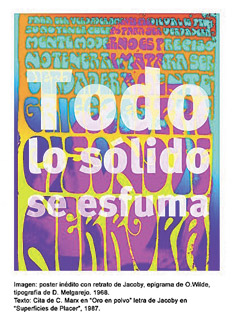 operated as part of the installation 1968: the ass you buckle, in the gallery Appetite, 2008.
operated as part of the installation 1968: the ass you buckle, in the gallery Appetite, 2008. Sometimes Jacoby embodies that same place, sometimes it says, it keeps track and makes it look. In fact, his work can be thought of as the mapping of a figure almost invisible, the construction of a map to indicate the locations and modes of appearance and of hiding from the artist. An example of this was the level of the wild apple (1986), which drew a diagram of a Buenos Aires area, topography, institutions, parks, galleries, bookstores, bars and even hair salons in the city, where they constituted the fundamental spaces of sociability in the '60s art, and crosses were generated between artists and intellectuals of different ages, generations, tribes, genders and classes. From this perspective, the definition of the artist acquires a territorial dimension: it takes place and specific coordinates and identification Jacoby is for one of the forms of contemporary art practice. Another possible example is the Snowball project: a network of artists, curators said relations between creators from mutual recognition, and attempts to renew the fabric of art in the open condition by new technologies. Thus, through overexposure and the immediacy of the current scene, the work of Jacoby reformulated its proposal: where should an artist?
The boundaries of that search are on the one hand, boredom and, on the other, politics, or rather the revolutionary politics. Stendhal spent part of his novel Red and Black boredom generated by the daily autocratic bourgeois life, which matters only to make an impression on others without, in the end, nobody really enjoy that kind of success. Subject without desire, the bourgeois individual is subject to serialization, vacuum, as a form of control away from the political passion.
In Jacoby's work shows a first limit of what is left out of his universe and it is the indifference, languor, which could be called art in a coma. During the last military dictatorship in Argentina, the effect of terror, though not one personally and directly affected by the repression manifested as widespread inaction, paralysis, terror and boredom as expected mortal. That mood was part in the design of Jacoby, a passive response to the experience of state terrorism: "The political strategies of the military government had operated successfully on the bodies through the destruction, pain, prison, urban control and information systems, since their goal was what Clausewitz called 'the moral and intellectual forces', which is usually in the war the real goal for the destruction of natural or physical forces. Indeed acted on the mood of the population until the impulses of autonomy is almost extinct completely, "writes Jacoby (in joy and Strategy, 2000). Intervention
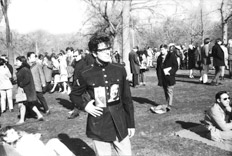 Mao and Peron, one heart, at Central Park in New York, 1967.
Mao and Peron, one heart, at Central Park in New York, 1967. In contrast, her practice going into politics, without ever leaving the creative work on the form. As part of that statement we find the set of actions that came to be called "happiness strategies" and that included, among many other proposals, their participation in the refreshing pop-rock group Virus since 1979 and later nomadic festivals in unconventional spaces that organized in the '80s. Virus formed part of a set of practices that were a way of resisting the climate of oppression not only through the use of humor in the lyrics of songs and composition from cheerful and danceable rhythms, but also by conditions production of shows, how to organize the room, the performative dimension of the shows. An invitation to avoid sitting or alone, to dance and celebrate with others.
In this imaginary territory, defined on its edges by the tedium and politics, which is at the junction is friendship, or in terms of Jacoby, the "technologies of friendship": a metaphor for the construction of groups gives us a clue about the figure of the artist that Jacoby wonders in terms of future and desire: for him an artist is, or better, someone who does not think as an individual but favors the collective production collaboration, group action. Hence his interest in experimental companies had their biggest institutions in 2004 when he directed the Experimental Area Companies in the Ricardo Rojas Cultural Center of the University of Buenos Aires, but goes much further back, the failed attempt to Part I, Internal. That project, conceived at the end of dictatorship in an attempt to break the isolation ruling, wanted to produce an exchange network of ideas, insights, readings, texts in the process, among a diverse list of intellectuals. Something that Internet then we got used, but in the early 80s meant riding a circulation system in network messages, images and text, photocopying, faxing and phone calls in a chain. Development of these circuits semi (known group, message series, multiple practices) was the Venus Project, where a group of artists is a virtual society, coining its own currency and immobile forms of government and fleeting, to exchange experiences, services , works, theories, events and public interventions.
find a link between these collective initiatives of Jacoby and assumptions about the intrigues and the groups to plan actions are parallel and alternative worlds that I outlined in my presentation Conspiracy Theory, which I explained in one of the Placido Domingo in which Venus project was conceived. It was a way to define non-secret conspiracy and threatening, but peaceful public. There, I proposed to the forefront as a political response, own specific procedures for the construction of cultural and political power implicit in liberalism, a response to the idea of \u200b\u200bconsensus and agreement as performance guarantees social visibility of public space, the notion of representation and majority as a form of legitimacy. The vanguard would come to question these notions, with its policy of sect, localized and explosive action, with their perception of the cultural logic conspiracy and production of value, as a war of positions. The model of society is leading the battle, not the covenant, is the exception and not the law. Alternative artistic practice does see what the key ideas proposed refuse and weaken the power centers and alter cultural hierarchies and systems of signification. Thus, the artistic vanguard clearly decoded illiberal practice, as a conspiracy version of politics and art, as a plot to experiment with new forms of sociability, that seeps into existing institutions and tends to dissolve and create networks and alternative forms.
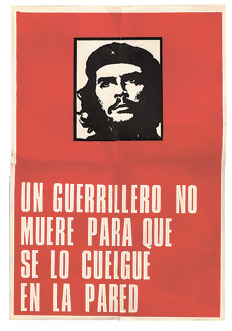 Anti-poster of Che Guevara with the phrase "A guerrilla is killed in order to hang it on the wall." 1969. Jacoby
Anti-poster of Che Guevara with the phrase "A guerrilla is killed in order to hang it on the wall." 1969. Jacoby done this type of intervention to create platforms to think together, connect and act outside the institutions. Artistic practice is collective and contingent, anyone can fill the temporary location and distance themselves from it: the figure of the artist is utopian, egalitarian and uncertain. Roberto's work poses the problem from the beginning in the '60s (us-the artists-dematerialized) and renewed until the present (in the intervention group and policy proposed in the Sao Paulo Biennial, 2010).
We are facing a long-term activity defined by the transformation and metamorphosis of art in these fifty years of Jacoby was not a precursor but an artist that illuminates previously secret practices will hear time after an extended and shall immediate understanding. His work has the dual temporality of irony, the meaning is not understood at the time but after an uncertain period the laughter finally illuminates the darkness. The art collection is deferred, the future effect, Jacoby is the ironic artist, who lives as if evil would combine tenses, jarringly, untimely, is untimely.
2. WAYS TO MAKE
Jacoby In what sense can be considered an artist ironic? In line with proposals such as Marcel Duchamp, William Burroughs and Macedonio Fernández, Jacoby thinks more about the artistic act, the action of creating, in the work as finished product. It is in this gesture as I read the imprint of dematerialization in his work: the artistic action is more important than the result Likewise, the invention is not directed toward the object in the full sense but the object is a starting point for building an experience. That to me is the importance of the concept of dematerialization Masotta resumption of the Lissitsky and Jacoby and his team put into practice.
In that sense, his league dematerialisation to everyday technological advances rather than mass media. Technological development is a tool that Jacoby used to produce conceptual effect. Lissitsky say, before one to send a letter using paper, buy an envelope, sat down to write, went to the mail, etcetera. The same message is now sent in a intangible, almost abstract. It is the use of new technologies that go beyond what we traditionally call "media" and Roberto envisioned decades ago, his interest in the formation of connections in real time before the web, the artistic uses of the recorder, the teletype, typing, stencils, the mimeograph, the old copiers, faxes, answering telephone, television, video, infrared vision. It was, in all cases, construction of networks of exchange and circulation of works that were directed specifically to a known community. The artist, in principle, works for a network of friends.
Seen in perspective, it seems that their projects had been awaiting the arrival of the Internet to operate retrospectively in the manner of "Kafka and his precursors." The current conditions can decipher the multiple meanings of interventions and practices that were once considered a minority and closed. For Jacoby, then and now-it's the creative uses of social technology available at all times. Dematerialization accompanies the technical development: the increasingly lightest of messages and transforms them into conceptual means. This is not the dissolution of the object or change context of artistic perception, but the abstract work of reproduction, the number, speed and the ways that technology makes available to society. The technical tools-of print, radio, television, digital network, are the true ready made contemporary art. The current artist is like the Doctor Mabuse, is a cyber illusionist, politicized and mutant, which identifies ways of doing things.
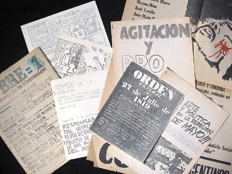 with Umberto Eco that impacted 1969.
with Umberto Eco that impacted 1969. In his essay "The Philosophy of Composition," Poe establishes a highly productive literary tradition: it explains how is a poem for others to make a poem. So did by inventing the detective story and an unforgettable and daring thinker Auguste Dupin. Poe defined the necessary elements to create an intrigue (the criminal, the detective, the victim, the story told in reverse chronological order, etc.) and from that developed conceptually one of the most popular genres of modern fiction . The artist is a creator of forms. In that tradition is recognized Baudelaire, Mallarmé, Raymond Roussel, Borges, the Oulipo group. Similarly, the experience of Jacoby is an artist that builds not only works, but ways of doing work. Art is a potential open, available, a magnetic field of programmatic projects that anyone can activate. Jacoby, as we know, make up styles, procedures, creative concepts, uses them and leaves them to find new ways and new relationships. Constant renewal, permanent revolution, is part of his artistic and political work against the inertia, the repetition, the aesthetics of the bureaucracy always the same. Therefore, their frequent changes in registration (writing, images, research, theory, music, theater, performances, installations): the renewal of languages \u200b\u200bis one of his trademarks as an artist.
Art, Stendhal said, is imminent happiness is always to come, we must be alert, to experiment, go to see, reach utopia. Ways of making art have to do, rather than artistic strategies "pure" - life forms that aspire to happiness. That is the central feature of the poetics of Jacoby. There is nothing specific on the specifics of art, but the attitude, attentive and available, the artist to the good life. So the many ways to do tend to blur the boundaries between life and art: to change the language need to change the way we live. Yet imagine art forms of life to which reality is not ready. Working with effort, with still is, around two major reasons are reiterated in the work of Jacoby: revolution and sexuality. The micro-pilot, technology, friendship, fugitive networks, local alternatives, are places of artistic and political experimentation. Art is a stateless society, the reality of everyday life. Jacoby reminds me of the experience of utopian anarchists who decided to make its proposal for a new society in his personal life. These ways of life possible, which included other sexual habits, other care of the body, the absence of money, the socialization of personal property, identity transformations, clothing, food, afterlife were programs that made this, sought to change the feelings, conceptions and perceptions of reality. That desire for a new life is the condition for Jacoby's artistic practice.
As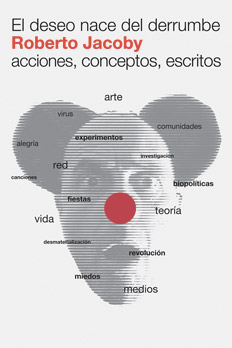 catalog shows that opened on 25 February at the Museo Nacional Centro de Arte Reina Sofia (Madrid) and will run until May 30 this year, will present the book "The desire is born of the landslide. Roberto Jacoby, writings, actions, concepts (Buenos Aires / Barcelona, \u200b\u200b2011), which holds its first projects, statements, songs, conversations and other texts by the artist and sociologist. The book is the result of years of research of the conceptual network of the South and is published under the imprint of Editions La Central, Adriana Hidalgo Editora National Museum Reina Sofia Art Center, edited by Ana Longoni care.
catalog shows that opened on 25 February at the Museo Nacional Centro de Arte Reina Sofia (Madrid) and will run until May 30 this year, will present the book "The desire is born of the landslide. Roberto Jacoby, writings, actions, concepts (Buenos Aires / Barcelona, \u200b\u200b2011), which holds its first projects, statements, songs, conversations and other texts by the artist and sociologist. The book is the result of years of research of the conceptual network of the South and is published under the imprint of Editions La Central, Adriana Hidalgo Editora National Museum Reina Sofia Art Center, edited by Ana Longoni care. 3. A Cicero PAMPAS
My relationship with Robert is in some sense, generational: forking paths and meet again. We started together as it were and still are starting. I think this will start again, the illusion of doing something different and not always repeated, is a mark of those years.
We met at a party at the home of a friend, Gioia Fiorentino circa 1963 or 64. They started talking and since then have been very attentive to what he does. It is one of the most generous and creative culture in Argentina, perhaps the most creative I know. Is a constant generator of ideas, yet everything that happens in the politics and cultural life. He always had a very accurate eye for identifying emerging trends, to draw attention to artistic or political issues with great skill. As a sort of cicerone, and Cicero-cultural world, Roberto is the one who knows see who calls and makes possible, that defines power and style.
always remember that we went together to see Umberto Eco, that was passing through Buenos Aires, invited by the Instituto Di Tella, and bring you the magazine on that Roberto was doing at that time (1969). We are at a bar in Florida and Eco-street at that time as a theorist of Group 63 was one of the leaders of the European vanguard, was surprised by a magazine which first had to be broken to access an unexpected combination of multiple materials : comic books, pamphlets, slogans, statements, theses, life stories, drawings, diagrams. There was no fixed order and removing these leaves Eco photocopied would not understand at all what I was seeing and, in any case, but their categories would allow Argentina figure that fight art, politics, popular culture and propaganda.
When we returned that afternoon to walk down the street and Corrientes had once again convinced that Jacoby was one step ahead of the latest actions of contemporary art. Advanced position, its unclassified position has left alone many times but always held there, with ethics ironic artist who can turn invisible to persist. That's one of the great lessons of his work. So I think that the exhibition which opens on these days in the Reina Sofia Museum in Madrid is an event that will reconstruct the extraordinary career of an artist that is now finally together much (Which probably no longer upset him.)
Cover image: I am not a clown in the gallery Beauty & Happiness. 2001 Photo: Paul Mehanna
(*) TEXT PUBLISHED IN CHARGE OF DAILY radar-page 12 -, 2011 .- Sunday 20 febreo

